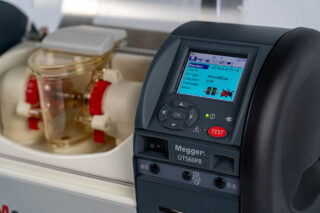Based in Mountain View, California, Waymo is a self-driving technology pioneer that was born as a project within Google. Since 2020, Waymo has operated a fleet of electric driverless taxis, often spotted cruising the streets of select American cities like Phoenix, Arizona. But as of November 12, everyone in select neighborhoods of Los Angeles can now hail them, following a similar rollout in San Francisco earlier this year in June. While in LA, we took a ride in one of these Level 4 autonomous vehicles.
Waymo, now a subsidiary of Alphabet, operates a fleet of Jaguars that function like Uber or Lyft vehicles and are accessible to anyone via the Waymo One app 24/7. However, unlike traditional ride-share services, Waymo’s cars are Level 4 autonomous vehicles, meaning they operate without a human driver, making decisions entirely on their own.
DirectIndustry took a ride in one of these futuristic vehicles, from Venice Beach to Santa Monica in Los Angeles. The iconic city of the film industry provided the perfect backdrop for this transformative technology to showcase its capabilities.
Watch our video
Step 1: Booking Your Ride
To start, you book your trip using the Waymo One app. Once your car arrives at the designated pick-up location, you unlock the door directly from the app.
The Autonomous Journey
Upon entering, you’re greeted by a friendly voice instructing you to fasten your seatbelt. A soothing background music sets the tone for your journey. You can even connect to the car’s app and play your own music.
After you press the “Start Ride” button, either on the app or the car’s screen, the journey begins. The steering wheel moves entirely on its own as the car effortlessly navigates the streets, selecting the best routes, signaling turns, and slowing down for pedestrians.
This is all made possible by a sophisticated combination of advanced LiDAR sensors, cameras, and radar, which constantly gather real-time data. An AI system then processes this information to make driving decisions.
The vehicles feature 13 cameras that provide a 360-degree view around the car. These cameras capture high-resolution images, enabling the system to detect and classify objects such as pedestrians, cyclists, and other vehicles.
Four LiDAR (Light Detection and Ranging) sensors emit laser pulses to create detailed 3D maps of the environment. This technology allows the vehicle to measure the size and distance of objects up to 300 meters away, regardless of lighting conditions.
Six radar units complement the cameras and LiDAR by detecting objects and measuring their speed and distance, even in adverse weather conditions like rain or fog.
External Audio Receivers (EARs) capture sounds from the environment, such as emergency vehicle sirens, providing additional context for the vehicle’s decision-making processes.
This integrated sensor array enables Waymo’s vehicles to navigate complex urban environments safely and autonomously.
Inside, a built-in screen allows passengers to monitor the route as the car progresses.



Safety on the Road
During our ride, we never felt unsafe at any point. Waymo’s autonomous vehicle strictly adhered to traffic laws, respected all signage, and maintained the speed limit. It signaled appropriately when turning and executed turns smoothly and predictably.
The car slowed down near pedestrian crossings and demonstrated an impressive ability to handle complex scenarios. For example, it reacted well to the numerous joggers near Venice Beach who alternated unpredictably between the road and the sidewalk. The vehicle adjusted its speed and slightly veered to maintain a safe distance, ensuring a seamless and cautious interaction with its surroundings.
This level of attentiveness and precision highlights the reliability and sophistication of Waymo’s autonomous driving technology.
Arrival and Fare
At the drop-off point, the car halts precisely where needed. For a 4-mile trip, the fare was $16—which is similar to traditional ride-hailing services.
As you exit, the car departs to pick up its next passenger.
Waymo’s autonomous cars represent a significant step forward in transportation technology. With their focus on safety, efficiency, and innovation, they’re not just redefining mobility—they’re paving the way for a driverless future.
Last month, the company secured a $5.6 billion funding round, a clear indication of its confidence in the future of autonomous driving. This substantial investment underscores Waymo’s belief in the growing adoption of self-driving technology and its commitment to expanding operations as the technology continues to mature.
Looking ahead, the company plans to extend its services to additional cities, further broadening the reach of its autonomous vehicle network. This expansion reflects Waymo’s ambition to become a key player in reshaping urban mobility.











